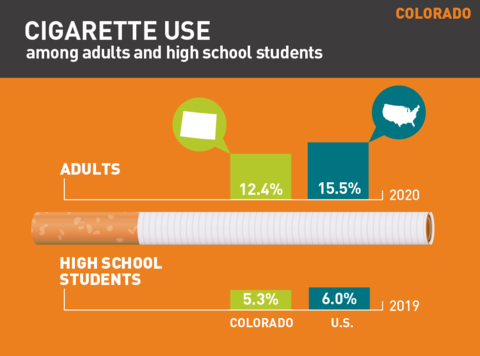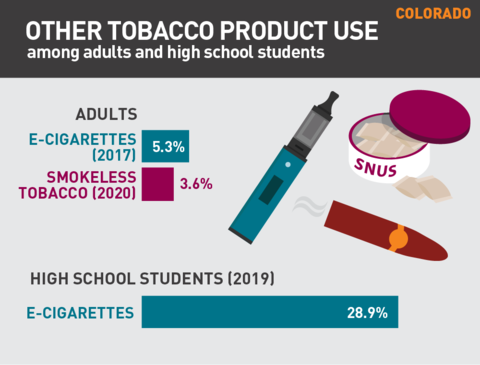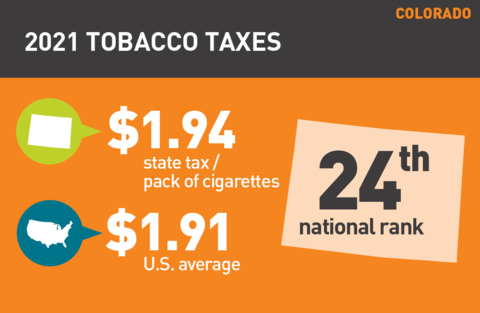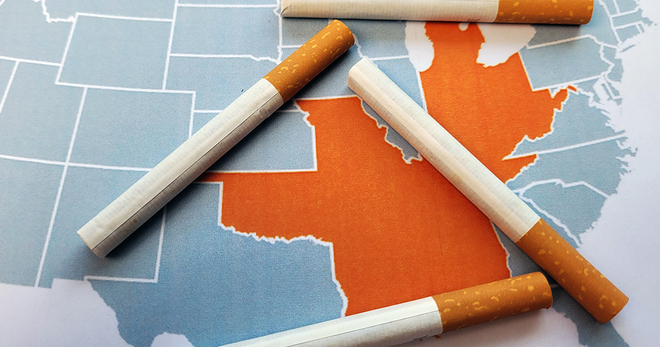Tobacco use in Colorado 2021
Cigarette use: Colorado*
Cigarette smoking rates in Colorado
- In 2020, 12.4% of adults smoked. Nationally, the rate was 15.5%.1
- In 2019, 5.3% of high school students in Colorado smoked cigarettes on at least one day in the past 30 days. Nationally, the rate was 6.0%.2
Other tobacco product use: Colorado
Vaping rates in Colorado
- In 2017, 5.3% of adults in Colorado used e-cigarettes.3
- In 2020,3.6% of adults in Colorado used smokeless tobacco.3
- In 2019, 28.9% of high school students in Colorado used electronic vapor products on at least one day in the past 30 days. Nationally, the rate was 32.7%.2
Economics of tobacco use and tobacco control
Colorado cigarette tax
- Colorado received $339.8 million (estimated) in revenue from tobacco settlement payments and taxes in fiscal year 2021.4
- Of this, the state allocated $20.0 million in state funds to tobacco prevention in fiscal year 2021, 37.8% of the Centers for Disease Control and Prevention’s annual spending target.4
- Smoking-related health care costs: $1.89 billion per year.4
- Smoking-related losses in productivity: $1.27 billion per year.5
Colorado tobacco laws
Colorado smoking laws
Tobacco taxes
- Colorado is ranked 24th in the U.S. for its cigarette tax of $1.94 per pack (enacted January 2021), compared with the national average of $1.91. (The District of Columbia has the highest tax at $4.50 and Missouri has the lowest at 17 cents.) 6-8
- All other tobacco products are taxed at 40% of the manufacturer’s list price.6,7
Clean indoor air ordinances
- Smoking is prohibited in all government and private workplaces (nonpublic workplaces with three or fewer employees are exempt), schools, childcare facilities, retail stores, recreational/cultural facilities, restaurants, bars (cigar/tobacco bars are exempt) and casinos/gaming establishments (tribal establishments are exempt).6,7
- E-cigarettes are included in the state’s clean indoor air law.9
Licensing laws
- Retailers are not required to obtain a license to sell tobacco products. Wholesalers are required to obtain a license to sell tobacco products.6
- A license is required to sell e-cigarette products.9
Youth access laws
- Effective December 2019, the United States adopted a law raising the federal minimum age of sale of all tobacco products to 21. Some states have not yet raised their state minimum age of sale, however, the federal law takes precedence.
- Establishments are required to post signs stating that sales to underage consumers are prohibited.6
- The sale or distribution of nicotine products to underage persons is prohibited.9
- Unless authorized by local license, no new license will be issued after July 1, 2021 to a nicotine product retailer located within 500 feet of a school.9
- A retailer may not advertise e-cigarette products in a manner that is visible from outside the retail location.9
- Delivery sales of nicotine products are only allowed after verifying the person receiving the delivery is at least 21 years old through valid government-issued photographic identification.9
Local tobacco laws
- Aspen, Carbondale, Glenwood Springs, and Snowmass Village prohibit the sale of all flavored tobacco products.10 Boulder prohibits the sale of flavored e-cigarettes.10
Quitting statistics and benefits
Quitting vaping and smoking in Colorado
- The CDC estimates 49.6% of daily adult smokers in Colorado quit smoking for one or more days in 2019.3
- In 2014, the Affordable Care Act required that Medicaid programs cover all quit medications.7**
- Colorado’s state quit line invests $5.87 per smoker, compared with the national average of $2.14.7
- Colorado has a private insurance mandate provision for quitting tobacco.7
Notes and references
Updated August 2021
*National and state-level prevalence numbers reflect the most recent data available. This may differ across state fact sheets.
**The seven recommended quitting medications are NRT gum, NRT patch, NRT nasal spray, NRT inhaler, NRT lozenge, Varenicline (Chantix) and Bupropion (Zyban).
Fiore MC, et al. Treating Tobacco Use and Dependence: 2008 Update. Clinical Practice Guideline. Rockville, MD: US Department of Health and Human Services. Public Health Service: May 2008.
1. CDC, Behavioral Risk Factor Surveillance System, 2020.
2. CDC, Youth Risk Behavioral Surveillance System, 2019.
3. CDC, Behavioral Risk Factor Surveillance System, State Tobacco Activities Tracking and Evaluation System, 2021.
4. Campaign for Tobacco-Free Kids, Broken Promises to Our Children: a State-by-State Look at the 1998 State Tobacco Settlement 22 Years Later FY2021, 2020.
5. Campaign for Tobacco-Free Kids, Toll of Tobacco in the United States.
6. American Lung Association, State Legislated Actions on Tobacco Issues (SLATI).
7. American Lung Association, State of Tobacco Control, 2021.
8. Campaign for Tobacco-Free Kids. State Cigarette Excise Tax Rates & Rankings. https://www.tobaccofreekids.org/assets/factsheets/0097.pdf. Accessed.
9. Public Health Law Center. U.S. E-Cigarette Regulation: 50-State Review. http://www.publichealthlawcenter.org/resources/us-e-cigarette-regulations-50-state-review. Accessed.
10. Truth Initiative, Local restrictions on flavored tobacco and e-cigarette products. https://truthinitiative.org/research-resources/emerging-tobacco-products/local-restrictions-flavored-tobacco-and-e-cigarette.
More in smoking by region
Want support quitting? Join EX Program
By clicking JOIN, you agree to the Terms, Text Message Terms and Privacy Policy.
Msg&Data rates may apply; msgs are automated.




